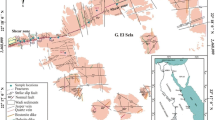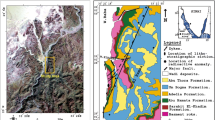Abstract
The contents of natural radionuclides in various types of sedimentary rocks in Um Bogma Formation and base of El Hashash Formation were determined by gamma-ray spectrometry. Three types of lower Carboniferous sedimentary rocks were investigated; sandstone (El Hashash Formation), dolostone and argillaceous sediments (Um Bogma Formation). The alteration processes are dolomitization, dedolomitization, karstification and lateritization. The specific radioactivity of 238U, 226Ra, 232Th and 40K determined in different samples, indicate that 238U and its decay products contribute primarily to the high natural radioactivity of rocks. The maximum concentration of 238U reached up to 2129.36 ppm in argillaceous sediments. The average concentrations of determined radionuclides (238U, 226Ra, 232Th and 40K) are 8.34 ppm, 7.88 ppm, 4.68 ppm and 0.3%, respectively in sandstone. In dolostones the average concentrations are 418.69 ppm, 808.75 ppm, 3.14 ppm and 0.29%, respectively. For argillaceous sediments are 276.88 ppm, 419.49 ppm, 11.47 ppm and 0.93%, respectively. The 238U/226Ra ratio in sandstone ranges between 0.89 and 1.25, while in dolostones and argillaceous sediments are 0.27–2.63 and 0.27–1.83, respectively. These variations in the concentrations of radioelements and their ratios are due to the action of the alteration processes affected these different sedimentary rocks in different times. Environmentally, the Raeq in dolostones and argillaceous sediments exceeds the permitted limits, while in the sandstone samples; it is within the permissible levels.



Similar content being viewed by others
References
El Sharkawi M, El Aref M, Abdel Mottelib A (1989) Manganese deposits in Carboniferous paleokarst profile, Um Bogma region, west central Sinai, Egypt. Miner Deposita 25:34–43
El Sharkawi MA, El Aref MM, Abdel Mottelib A (1990) Syngenetic and Paleokarstic copper mineralization in the Paleozoic platform sediments of west central Sinai, Egypt. Spec Publ Int Ass Sediment 2:159–171
El Aassy IE, Ahmed FY, Afifi SY, El Shamy AS (1999) Uranium in laterites, Southwestern Sinai, Egypt. In: First seminar on nuclear raw materials and their technology, Cairo, Egypt, 1–3 Nov 1999, pp 1–20
Segev A (1984) Gibbsite mineralization and its genetic implication for the Um Bogma Manganese Deposit, Southwestern Sinai. Miner Deposita 19:54–62
Mansour M (1994) Sedimentology and radioactivity of Um Bogma Formation, West Central Sinai, Egypt. MSc thesis, Faculty of Science, Suez Canal University, p 157
Mortvedt JJ (1994) Plant and soil relationships of uranium and thorium decay series radionuclides- a review. Environ Qual 23:643–650
Elles P, Lee SY (2002) Radionuclide-contaminated soil: a mineralogical perspective for their remediation. In: Dixon JB, Schulze DG (eds) Soil mineralogy with environmental applications, Chap 25. Soil Sci Soc of America, Madison, pp 737–763
Barnett MO, Jardine PM, Brooks SC, Selim HM (2000) Adsorption and transport of uranium(VI) in subsurface media. Soil Sci Soc Am J 64:908–917
Taboada T, Cortizas AM, García C, Rodeja EG (2006) Uranium and thorium in weathering and pedogenetic profiles developed on granitic rocks from NW Spain. Sci Total Environ 356:192–206
Van Schmus WR (1995) Natural radioactivity of the crust and mantle. In: Global earth physics: handbook of physical constants, vol 1. AGU Reference Shelf, pp 283–291
Faure G (1986) Principles of isotope geology, 2nd edn. Wiley, New York, p 589
El Aassy IE, Botros NH, Abdel Razik A, Sherif H, Al Moafy A, Aita S, El Terb R, Al Shami AS (1986) Report on the prospection and proving of some radioactive occurrences in west central Sinai, Egypt. Internal Report. Nuclear Materials Authority, Cairo
Weissbrod T (1969) The Paleozoic of Israel and adjacent countries. Part II. The Paleozoic outcrops in southwestern Sinai and their correlation with those of southern Israel. Bull Geol Surv Israel 48:1–32
El Agamy NL (1996) Geology and radioactivity studies on the Paleozoic rock units in the Sinai Peninsula, Egypt. PhD thesis, Fac. Sci., Mansoura Univ., p 302
IAEA (1987) Preparation and certification of IAEA gamma spectrometry reference materials, RGU-1, RGTh-1 and RGK-1. Report-IAEA/RL/148. International Atomic Energy Agency
Anjos RM, Veiga R, Soares T, Santos AMA, Aguiar JG, Frascá MHBO, Brage JAP, Uzêda D, Mangia L, Facure A, Mosquera B, Carvalho C, Gomes PRS (2005) Natural radionuclide distribution in Brazilian commercial granites. Radiat Meas 39:245–253
Stoulos S, Manolopoulou M, Papastefanou C (2003) Assessment of natural radiation exposure and radon exhalation from building materials in Greece. J Environ Radioact 69:225–240
Turhan Ş, Gündüz L (2008) Determination of specific activity of 226Ra, 232Th and 40K for assessment of radiation hazards from Turkish pumice samples. J Environ Radioact 99:332–342
Kim KW (1993) Influence of uraniferous black shales on trace elements in soils and crops in Korea. PhD thesis, Imperial College, University of London, p 410
Barth A, Jurk M, Weiß D (1998) Concentration and distribution patterns of naturally occurring radionuclides in sediments and flood plain soils of the catchment area of the river Elbe. Water Sci Technol 37:257–262
Papp Z, Dezsö Z, Darócz S (2002) Significant radioactive contamination of soil around a coal-fired thermal power plant. J Environ Radioact 59:191–205
Vandenhove H, Van Hees M (2004) Phytoextraction for clean-up of low-level uranium contaminated soil evaluated. J Environ Radioact 72:41–45
U.S. DOE (1997) Linking Legacies, Report DOE/EM-319, Washington, DC
Lee J, Kim S, Kim K, Kim IS (2005) Microbial removal of uranium in uranium-bearing black shale. Chemosphere 59:147–154
UNSCEAR (2000) United Nations Scientific Committee on the Effects of Atomic Radiation, “Sources and Effects of Ionizing Radiation”. Report to General Assembly, with Scientific Annexes United Nations. United Nations, New York
Őrgün Y, Altınsoy N, Şahin SY, Güngör Y, Gültekin AH, Karahan G, Karacık Z (2007) Natural and anthropogenic radionuclides in rocks and beach sands from Ezine region (Canakkale), Western Anatolia, Turkey. Appl Radiat Isot 65:739–747
Tufail M, Ahmad N, Mirza SM, Mirza NM, Khan HA (1992) Regular paper, Natural radioactivity from the building materials used in Islamabad and Rawalapindi, Pakistan. Sci Total Environ 121:283–291
Saito K, Jacob P (1995) Gamma-ray fields in air due to sources in the ground. Radiat Prot Dosim 58:29–45
Saito K, Pattoussi H, Zankl M (1998) Calculation of the effective dose and its variation from environmental gamma ray sources. Health Phys 74:698–706
Nada A (2003) Evaluation of natural radionuclides at Um-Greifat area, eastern desert of Egypt. Appl Radiat Isot 58:275–280
Sutherland RA, de Jong E (1990) Statistical analysis of gamma-emitting radionuclide concentrations for three fields in Southern Saskatchewan, Canada. Health Phys 58:417–428
Pöllänen R, Ikäheimonen TK, Klemola S, Vartti VP, Vesterbacka K, Ristonmaa S, Honkamaa T, Sipilä P, Jokelainen I, Kosunen A, Zilliacus R, Kettunen M, Hokkanen M (2003) Characterization of projectiles composed of depleted uranium. J Environ Radioact 64:133–142
Papachristodoulou CA, Assimakopoulos PA, Patronis NE, Ioannides KG (2003) Use of HPGe gamma-ray spectrometry to assess the isotopic composition of uranium in soils. J Environ Radioact 64(2–3):195–203
Zhang W, Yi J, Mekarski P, Ungar K., Hauck B, Kramer GH (2010) A gamma–gamma coincidence spectrometric method for rapid characterization of uranium isotopic fingerprints. J Radioanal Nucl Chem. doi:10.1007/s10967-010-0868-y
Yücel H, Cetiner MA, Demirel H (1998) Use of the 1001 keV peak of 234mPa daughter of 238U in measurement of uranium concentration by HPGe gamma-ray spectrometry. Nucl Instrum Method Phys Res A 413:74–82
Strakhov NM (1958) Facts and hypotheses concerning the genesis of dolomite rocks. Izv Akad Nauk SSSR Ser Geol No 6, p 1–18 (AGI trans, 1960)
Teodorovich GI (1961) Authigenic minerals in sedimentary rocks. Translated from Russian. Consult. Burea, New York, p 120
Smith SC, Peper SM, Douglas M, Ziegelgruber KL, Finn EC (2009) Dissolution of uranium oxides under alkaline oxidizing conditions. J Radioanal Nucl Chem 282:617–621. doi:10.1007/s10967-009-0182-8
Wright RJ (1977) Unconformity uranium deposits; from uranium deposits in Africa, Geology and Exploration. IAEA-AG-109/12, pp 205–237
Daly RA (1909) First calcareous fossils and the evolution of the limestones. Bull Geol Soc Am 20:153–170
Goldberg M (1967) Supertidal dolomitization and dedolomitization in Jurassic rocks Hamakhtesh Hagatan, Israel. J Sed Petrol 37:760–773
Tucker ME (2003) Sedimentary rocks in the field. Wiley, Chichester, p 234
Noubactep C, Sonnefeld J, Merten D, Heinrichs T, Sauter M (2006) Effects of the presence of pyrite and carbonate minerals on the kinetics of the uranium release from a natural rock. J Radioanal Nucl Chem 270:325–333
El Aassy IE, Ahmed FY, Al Shami AS, Shata AE, Gabr MM, Rizq AA (2006)Geochemical differentiation in karst laterites, Sinai, Egypt. In: 7th international conference on geochemistry, Alex. Univ., Alexandria, Sept 6–7, 2006
Rezzoug S, Fernex F, Michel H, Barci-Funel G, Barci V (2009) Behavior of uranium and thorium isotopes in soils of the Boréon area, Mercantour Massif (S.E. France): leaching and weathering rate modeling. J Radioanal Nucl Chem 279:801–809
Georgakopoulos A (2000) The Drama lignite deposit, Nothern Greece: insights from traditional coal analyses, rock-eval data, and natural radionuclides concentrations. Energy Sources 22:497
Tsikritzis LI, Fotakis M, Tzimkas N, Kolovos N, Tsikritzi R (2008) Distribution and correlation of the natural radionuclides in a coal mine of the West Macedonia Lignite Center (Greece). J Environ Radioact 99:230–237
Tzortzis M, Tsertos H, Christofides S, Christodoulides G (2003) Gamma radiation measurements and dose rates in commercially-used natural tiling rocks (granites). J Environ Radioact 70:223–235
Abbady AGE, Uosif MAM, El-Taher A (2005) Natural radioactivity and dose assessment for phosphate rocks from Wadi El-Mashash and El-Mahamid Mines, Egypt. J Environ Radioact 84:65–78
Rahman SU, Matiullah MF, Rafique M, Anwar J, Ziafat M, Jabbar A (2011) Measurement of naturally occurring/fallout radioactive elements and assessment of annual effective dose in soil samples collected from four districts of the Punjab Province, Pakistan. J Radioanal Nucl Chem 287:647–655. doi:10.1007/s10967-010-0819-7
Author information
Authors and Affiliations
Corresponding author
Rights and permissions
About this article
Cite this article
El Aassy, I.E., El Galy, M.M., Nada, A.A. et al. Effect of alteration processes on the distribution of radionuclides in uraniferous sedimentary rocks and their environmental impact, southwestern Sinai, Egypt. J Radioanal Nucl Chem 289, 173–184 (2011). https://doi.org/10.1007/s10967-011-1059-1
Received:
Published:
Issue Date:
DOI: https://doi.org/10.1007/s10967-011-1059-1




